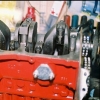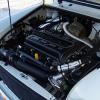"parts left out cost nothing and cause no problems". So why would a manufacturer install parts that were not needed?
That's a good question and in all fairness it needs to be followed up with the Question;- "Why was it later done away with?"
It was done at a time well before heaters were used on the A Series. With the take off on the head to the lower hose and then later, via a sandwich plate, there's well enough radiator 'by-pass' without adding to it. It was also felt that circulation was always needed, be it through the radiator or not. Having it does assist with filling the system too.
Also, these were designed at a time when coolants weren't in common use. This engine series was designed in the late 40 and first running in the early 50's.
Bear in mind, the By-pass doesn't By-pass the Thermostat, but the Radiator. Even when the Thermostat opens, a considerable flow of coolant flows via the By-pass and so goes un-cooled, continually dumping hot coolant directly in to the coolant inlet. Hardly conducive to trying to cool an warm or hot running engine.
That's just it though, the bypass was never done away with on later cars, it was just done in a different way.
The 1992 onward 1275 carb engines retained the old type bypass hose between the cylinder head and the water pump. There was a sandwich plate under the thermostat housing which fed the heater circuit only, this did away with the heater take off on the cylinder head near cylinder 4. The bottom hose has one connection on it.
The 1992 onward SPi engines did away with the old style bypass hose. Again there was a sandwich plate under the thermostat housing which fed the heater circuit like the carb engine, but also fed the water jacket in the inlet manifold, which then returned to the bottom hose. The SPi bottom hose has has two connections on it. The coolant temp sensor is mounted in the bottom of the inlet manifold, so there must be a constant coolant flow, therefore, a bypass.
The 1996 onward MPi engines, much the same as the SPi engines fed the heater circuit from the sandwich plate, but on the MPi bottom hose, there is a direct connection from the heater circuit off the sandwich plate direct to the bottom hose. This is the 'T' section that can be seen on the bottom hose. There is a plastic restrictor in this connection into the bottom hose which is about 6 or 7mm in diameter. The bottom hose has three connections on it (the third for the expansion tank).
The purpose of the bypass is to allow some circulation of coolant across the thermostat wax element all the time. Without any sort of bypass, the coolant will stagnate, and the only way for hot coolant to reach the wax element of the thermostat is by convection, that is until the thermostat starts to open.






















